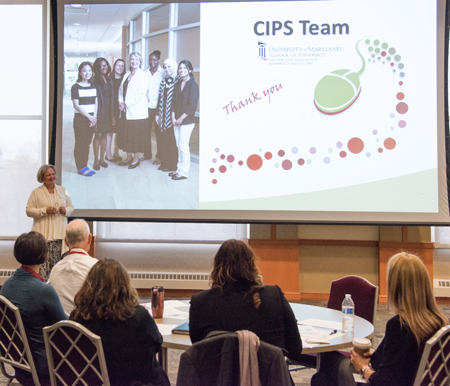Researchers from the latest round of seed grants awarded by the University of Maryland, Baltimore’s (UMB) Center for Interprofessional Education presented their results at the second annual IPE Seed Grant Symposium on Nov. 14.
Scientists in 2015-2016 examined topics including effective methods of achieving respect in an interprofessional team of students, partnering providers with families for better outcomes in children and teaching interprofessional techniques online.
The center’s seed grant program began in 2014, offering $5,000 to $10,000 seed grants to support 13-month pilot projects examining new ideas in interprofessional education or interprofessional team-based care. New projects have been funded each year as the seed grant program continues. Interprofessional education is a major focus of UMB President Jay A. Perman, MD, and a tenet of the University’s 2011-2016 Strategic Plan.
In opening the Nov. 14 symposium, Jane M. Kirschling, PhD, RN, FAAN, dean of the University of Maryland School of Nursing (SON) and director of the Center for Interprofessional Education, thanked the center’s co-directors, Heather Congdon, PharmD, BCPS, CDE, assistant dean for the School of Pharmacy (SOP) at the Universities at Shady Grove, and David Mallott, MD, associate dean for medical education at the School of Medicine (SOM), for helping to make the center and its seed grants possible. She also thanked and introduced Perman.
“The interprofessional approach holds out the hope of being better care that is more affordable,” said Perman. “People say to me, ‘It’s very nice what you say, but show us the data.’ In your projects, you are building the case for interprofessional care. We needed this research to either validate or repudiate these ideas.”
Researchers from each of five funded projects discussed their results, usually early studies on new ideas in interprofessional education and practice. Interprofessional education aims to prepare professionals in all disciplines – medicine, law, dentistry, pharmacy, nursing and social work, representing the six fields taught at UMB – to work together, sharing their respective expertise to ensure the best outcome for patients and clients.
Jill Morgan, PharmD, BCPS, associate professor and chair of the Department of Pharmacy Practice and Science at the SOP, discussed her examination of interprofessional education in the ambulatory care setting. For her $10,000 research project, she partnered with Elsie Stines, DNP, CRNP, assistant vice president for special projects and initiatives at UMB; Margaret Martin, RN, BSN, a pediatric nurse in the President’s Clinic run by Perman at the University of Maryland Children’s Hospital; Barbara Nathanson, MSW, LCSW-C, a clinical instructor at the School of Social Work (SSW); and Victoria Marchese, PT, PhD, associate professor in the SOM Department of Physical Therapy and Rehabilitation.
The research examined whether education could improve providers’ attitudes toward interprofessional approaches to care. The study found that, indeed, the program did improve attitudes. “No one should infer from this that team-based care is for everyone,” she said. “These models are for patients with complex needs – complex, chronic disease.”
Sarah Edwards, DO, assistant professor in the Department of Psychiatry at the SOM, presented on her project examining how students from nursing, medicine, occupational therapy and social work could use relational skills to partner with families in an inpatient child psychiatry unit. For the $10,000 project, Edwards partnered with Debra Scrandis, PhD, PMHNP-BC, an associate professor in the School of Nursing (SON), to look at using a Family Game Night on the unit to get parents more involved in care. The hope was to enable families to better manage the child psychiatric patients, who typically exhibit disruptive behavior, aggression, ADHD, and post-traumatic stress disorder, among other symptoms and conditions.
The study found “family game night was a nice environment to educate families and ease their transition [to discharge] so the families feel empowered,” Edwards said.

Roxanne Zaghab presents her research into an online approach to interprofessional education.
Roxanne Zaghab, DK, CKM, director of the Center for Innovative Pharmacy Solutions’ Knowledge Enterprise online learning platform at the SOP, presented on her research looking into an online approach for interprofessional education. Zaghab partnered with Eleanor Perfetto, PhD, MS, professor at the SOP; Kerri Thom, MD, MS, professor at the SOM; Mary Johantgen, PhD, RN, associate dean for the PhD program and associate professor at the SON; Jay Unick, PhD, MSW, associate professor in the SSW; Richard Manski, DDS, PhD, MBA, professor and chair of the Department of Dental Public Health at the School of Dentistry; and Matthew Pickering, PharmD, a postdoctoral fellow in the SOP.
Zaghab reported that her four-hour online course elicited positive responses from students, though they experienced “the usual challenges of online group work. The students felt their future practice would benefit” from interprofessional approaches.
Barbara Resnick, PhD, CRNP, professor and chair of the Department of Gerontology at the SON, headed up a $10,000 project exploring case-based approaches for teaching interprofessional approaches to care to students in nursing, pharmacy, and social work during their clinical education in a local high-rise senior housing community in Baltimore. That project was a partnership with Kelly Flannery, PhD, RN, assistant professor at the SON; Nicole Brandt, PharmD, executive director of the Peter Lamy Center on Drug Therapy and Aging and professor at the SOP; and Kelley Macmillan, PhD, MSW, clinical associate professor and chair of the aging specialty at the SSW.
Kathleen Pincus, PharmD, BCPS, assistant professor in the SOP, and Leila Islam, PhD, LCP, assistant professor at the SOM, used a $9,800 grant to study how medical, pharmacy, and social work students could work in teams to identify and address the medical, pharmaceutical, and psychosocial needs of patients in a patient-centered medical home. The patients were particularly complex, and had been identified as high-utilizers of the health care system. The two lead investigators partnered Mozella Williams, MD, of the SOM; Harriet Mandell, LCSW-C, of the SSW; Sharon Feinstein, MD, assistant professor at the SOM; and Sally Snader, RN, BSN, of the SON.


